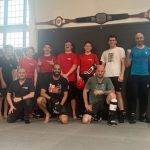Welcome to Fusion
Safe Practice
Fusion Martial Arts & Fitness in association with Martial Arts GB & Sport England, Safe Practice Policy and Procedures.
Introduction
Martial Arts are activities where safe practice is essential to help prevent injury. *Children are particularly vulnerable as they are still developing mentally and physically, so training methods need to be modified as described below. (*also includes Adults at Risk)
1.- General Health & Safety recommendations for Safe Practice
The following suggestions are recommended to ensure the safe practice of martial arts:
- If you have a medical condition, are overweight, are over 40 years of age or haven’t exercised regularly, see your doctor for a check-up
- If you are thinking of enrolling your child in a martial arts program, consult with your doctor first if you have concerns. A medical check-up can help identify any particular injury risks your child may have
- Warm-Ups: All activities should first include a thorough warm-up, head-to-toe stretching and gradual cardiovascular activity. Most martial arts disciplines recommend sustained stretching for at least 15 minutes before any kicks and punches are thrown. To help reduce injury, specific attention should be paid to those muscle groups that will be used during later activity
- Drink plenty of water before, during and after the activity
- Allow time to cool down after the activity. Stretching is an important part of your cool-down routine
- Obey all the rules of your martial art
- Seek advice from your martial arts teacher if you think your technique needs improving
- Wear appropriate protective equipment like helmets and mouthguards
- Try to put the emphasis on fun rather than the competition if your child is participating in martial arts
- Make sure your child understands that playing through pain is wrong
2.- Risk Factors
Some of the factors that can increase the risk of injury include:
- Poor technique: holding or moving the body incorrectly can put unnecessary strain on joints, muscles and ligaments
- Using excessive force: failing to pull a punch or kick can inflict injury on an opponent
- Inexperience: beginners are more likely to get hurt because their bodies are not used to the demands of the sport
- Overtraining: training too much and too often can lead to a wide range of overuse injuries
3.- Martial Arts involving throwing and grappling
The risks may include falling on unsuitable surfaces, landing on the head and/or damage to the joints from locks. Safe practice must include:
- Checking the training area for the suitability, particularly where the mats have been joined
- Checking that there are no hard surfaces or sharp/hard objects around the training area
- Having an experienced instructor who will ensure that correct tuition in the use of locks and throws to reduce the risk of injury to their training partner
4.- Martial Arts involving strikes, punches and kicks
The risks may include concussion from heavy blows to the head, damage to internal organs and joints from heavy blows and/or injury from inappropriate stretching and other exercises. Safe practice must include:
- Technical controlled sparring. (Controlled sparring or light contact means the technique is targeted but controlled so that whilst the opponent is touched the technique is not followed through)
- Avoid extremely excessive exercises such as press-ups on the knuckles or hitting heavy bags; the joints of children are still developing and can be damaged by these exercises
- Avoid full contact shots to the head throughout class sparring for all students, both adults and children under the age of 16 years. This contact should be light and controlled. Protective head guards are worn at all times when sparring. Head contact is excluded for children under the age of 8 years.
5.- Martial Arts involving weapons
Safe practice must include:
- No live blades (sharp or otherwise) in the training area when children are present
- Safe protocols for the use of training weapons by children
- Good supervision at all times by Instructors
6.- What to do if you injure yourself
If an injury occurs, you must stop training immediately to help prevent further damage.
- Seek prompt treatment of injury, as early management will mean less time away from training
- Treat all soft tissue injuries (ligament sprains, muscle strains, bumps and bruises) with rest, ice, compression, elevation (raise the limb above your heart) and seek advice from a health professional
- Do not resume activity until you have completely recovered from injury.
Above all, safe practice means having a suitably qualified and experienced instructor who will ensure that children are not exposed to the above risks and who can make a training session enjoyable whilst maintaining the discipline essential to learning a Martial Art.
We are committed to reviewing our policy and good practice annually.
This policy was last reviewed on: 01/01/2025





